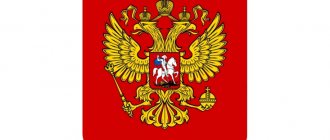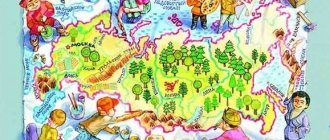Mammals
The list of mammals in Russia includes about 300 species. Of these, several dozen representatives of the animal world are included in the KKRF. They belong to the following groups:
- Predatory;
- Insectivores;
- Chiroptera;
- Rodents;
- Cetaceans;
- Pinnipeds;
- Artiodactyls;
- Odd-toed ungulates.
Amur tiger
The Amur or Far Eastern tiger lives in the southeastern part of Russia. This is a protected area spreading along the banks of the Ussuri and Amur rivers. According to the 2015 census, the number of these animals was 523-540 individuals.
Amur tiger
For example, in 2013 there were fewer tigers - 450. The main reason for the extinction in the 19th century was human activity - every year the number of tigers decreased by an average of 100 individuals.
Experts plan to resettle Amur tigers in the area of the Pleistocene Park (Yakutia).
Then it will be possible to increase their population to 75 individuals. But for this it is necessary to increase the population of artiodactyl animals, which form the basis of the tiger’s diet. In addition to deer, roe deer, and moose, they feed on small animals, birds, and fish. Tigers need about 10 kg of meat per day. Interesting fact : the Amur tiger is the only subspecies that has a 5 cm thick layer of fat on its belly. It helps animals survive even at very low temperatures.
Far Eastern leopard
Amur leopard, East Siberian leopard - this predator has up to 5 names. It is considered the rarest subspecies. According to 2021 data, 87 individuals live in Russia. Their habitat is the Land of the Leopard National Park.
Far Eastern leopard
The decline in the number of Far Eastern leopards is associated with poaching. This includes the animals that these predators feed on. People are also destroying forests, a natural habitat. Due to the small number of the species, leopards reproduce within the same population, which has a bad effect on genetics.
The predator is nocturnal and hunts alone. The diet consists of other animals of any size, mainly ungulates. Large prey lasts a leopard about a week.
Snow leopard (irbis, snow leopard)
A large predator from the cat family, it is common in the mountains of Central Asia. In Russia these are Altai, Tuva, Krasnoyarsk Territory, Khakassia, Buryatia, and the Eastern Sayan mountain system. Due to the difficult conditions in which the snow leopard lives, it is one of the least studied species of its family. Perhaps the snow leopard population has not completely disappeared precisely because of its habitat.
Snow Leopard
According to estimates in 2021, the number of snow leopards in Russia is 63-64 individuals, of which there were more than 10 kittens. Evidence suggests that the population remains relatively stable. 2-3% of the total number of snow leopards live on the territory of the Russian Federation.
Officially, hunting snow leopards is prohibited. However, poaching continues to harm their population. Predators also suffered as a result of mass poisoning of rodents, which are part of their diet, with pesticides. Snow leopards lead a predominantly solitary lifestyle, but family groups are sometimes found. They feed on ungulates and small animals.
Central Asian leopard or Caucasian leopard
In Russia it is found in the North Caucasus. The Central Asian leopard lives in forests and dense bushes, preferring to stay close to rocks and stones. Predators feed on medium-sized ungulates (deer, mouflon, wild boar, etc.), and sometimes on small animals.
Central Asian leopard
The problem of the population of Caucasian leopards is more than relevant. There are about 1000 of them preserved in the world. The main cause of extinction is human activity. The exact number of animals within the Russian Federation has not been established. However, in 2007, a special program was approved to restore the leopard population in the Caucasus.
Sea lion
The sea lion or northern sea lion is the largest species in the eared seal family. Belongs to the second category of animals, that is, those whose numbers are declining. In Russia, sea lions began to noticeably disappear in 1890-1990 - from 115,000 to 15,000 individuals. According to the latest data, their population in Russian waters is about 20,000.
Interesting: Animals of Russia - mammals, birds, reptiles, amphibians, fish, photos and videos
Sea lions
Animals are found in the waters of the Sea of Okhotsk, Bering, and Japan, as well as along the Kuril Islands and Eastern Kamchatka. Sea lions prefer coastal areas and islands. Their life cycle consists of migrations and rookery periods.
The exact reason for the decline in the number of northern sea lions has not been established. Main factors: fishing, water pollution, warming, catching fish, which forms the basis of the diet of sea lions. Steller sea lions also have natural enemies - killer whales and brown bears.
Walrus
Walruses are the only representatives of their family. Juveniles are easy to distinguish from adults: the latter have huge tusks. According to the main classification, these pinnipeds are divided into Pacific and Atlantic. Another subspecies is the Pacific Laptev walrus.
Walrus
Interesting fact : the walrus is the largest species in the group of pinnipeds after the elephant seal. However, walruses and elephant seals are not found in the same areas, so the walrus family can be called the largest in its range.
The Atlantic and Laptev walruses are listed in the KKRF. The population of the first species in Russia is about 20 thousand, the second – up to 10 thousand individuals. In the case of the Atlantic walrus, the number of individuals was significantly reduced due to uncontrolled fishing. The population is also affected by climate change, natural enemies, and parasites.
Walruses live in the waters of the Chukchi, Bering, Kara, East Siberian, and Laptev Seas. They prefer coasts and do not move long distances.
harbor seal
The common seal is a predatory mammal, two subspecies of which (European and Kuril) are listed in the Red Book of Russia. Seals are common in the seas belonging to the Arctic Ocean. They live in the coastal zone, bays where strong winds do not blow. There is also a population of seals on the Commander Islands.
harbor seal
The number is declining for several reasons: poaching, global warming, human activity in the coastal zone, attacks by natural enemies (polar bears, killer whales). The number of individuals has recently been 4-6 thousand.
Narwhal
The narwhal is the only representative of its genus. It is included in the 3rd category of animals, as a rare species with a small number of individuals. The exact number of narwhals is unknown, but in 2021 scientists discovered about 30 individuals, including calves.
Narwhal
The usual habitat is the waters of the Arctic Ocean and the northern part of the Atlantic. Narwhals suffer most from poaching, as well as from natural predators - killer whales, polar bears, polar sharks.
bottlenose dolphin
The bottlenose dolphin (large dolphin) is a species of dolphin. There are several of its subspecies. In particular, the Black Sea bottlenose dolphin, which lives in the waters of the Black Sea (about 7 thousand individuals), is listed in the Red Book of Russia.
bottlenose dolphin
Since 1996, fishing for these dolphins has been prohibited. Bottlenose dolphins are disappearing for many reasons: fishing, netting, poaching, pollution of ocean waters with household waste, noise pollution.
Bottlenose dolphins prefer a sedentary lifestyle or move in small groups. As a rule, they live near the coast, which is explained by the nature of their diet. The diet of dolphins includes a variety of fish.
Interesting fact : a characteristic feature of bottlenose dolphins is their well-developed cognitive abilities. For example, they understand gestures, monitor their behavior, imitate people, etc.
Blue whale
The blue or blue whale belongs to the category of baleen whales. It is both the largest representative of cetaceans, and also, apparently, the largest animal that has ever lived on the planet (up to 33 m in length and weighing more than 150 tons).
Blue whale
Among the three subspecies, the northern blue whale is listed in the CCRF. It is considered typical because it was the first discovered and described. In general, blue whales are considered cosmopolitan - that is, widespread. However, they are rare in Russian waters. For example, near Cape Lopatka (Kamchatka).
The greatest threat to whales has become active fishing, which has been officially prohibited since 1966. The exact number of individuals is difficult to establish - different sources provide conflicting data. If in the 19th century the number was several hundred thousand, now it is up to 5000.
Currently, blue whales are suffering due to collisions with ships, water pollution, and increased noise levels. They also get entangled in nets.
Polar bear
The polar bear ranks second among the largest land predators (after the saltwater crocodile). Within the Russian Federation, the species is distributed in the waters of the Bering and Chukchi Seas, as well as on the Arctic coast of the Chukotka Autonomous Okrug. This is where the largest population in the world is concentrated.
Polar bear
Polar bears feed on marine mammals. They lead a solitary lifestyle. The animals are threatened by poaching, since hunting them has been prohibited in the Russian Federation since 1956. At the same time, polar bears have low reproductive potential. The number of species in our country is up to 7000.
Interesting: Red Book of the Krasnodar Territory - list, description of animals, plants, mushrooms with photos and videos
Altai mountain sheep (argali)
The Altai mountain sheep is a subspecies of argali (or argali) and lives in the South-Eastern Altai, in the south-western part of Tyva. These artiodactyls prefer mountainous areas, where they periodically migrate in a vertical direction (in search of plant food).
Altai mountain sheep
It is difficult to control the number of Altai sheep due to their natural habitat. Officially, the subspecies is endangered. The reasons are uncontrolled hunting, the need to leave the habitat (due to grazing of livestock and a decrease in the amount of food), natural enemies.
Features of the design of a lapbook about the Red Book
The cover of a handmade book can be made traditional - red with gold letters.
It is better to make the cover traditional - red with gold letters
You can imagine the famous Amur tiger on it.
The traditional symbol of the Red Book of Russia is the Amur tiger, you can put it on the cover
A good idea is to place on the cover images of animals against the background of a map of Russia.
Images of animals on a bright background will immediately attract children's attention.
Since the theme of the manual is “The Red Book,” there must be mini-books inside.
You should definitely include mini-books in your lapbook; children love them very much.
Images of animals can be presented both on cards and in the form of folding tapes.
Photos of animals can be accompanied by a brief description of them.
The lapbook should also include folding envelopes, for example, in the form of a pentagon. This is how you can formalize the rules of behavior in nature.
Unusual design elements always attract children
Photo gallery: examples of laptops on this topic
The laptop is large in size and has many different elements.
All envelopes are made in the same style - red with a picture and inscription pasted on
The envelopes have an interesting color - as if they were made of old yellowed paper
By moving the window, you can focus on a specific animal or plant
Birds
The large territory of the country is conducive to the settlement of various natural areas by all kinds of birds. About 100 species are listed in the KKRF. Many of them are common in national parks, game reserves and nature reserves.
black crane
Most black cranes nest in the country. The birds form several populations, whose habitats extend from the Central Siberian Plateau to the Sikhote-Alin.
black crane
The number of black cranes around the world is about 11,000. They feed on a variety of foods - both animal and plant foods. They prefer swampy areas and woody vegetation.
The population of black cranes is most actively threatened by human economic activities in the habitat areas of these birds. They migrate to Japan, where living conditions are quite good, but epidemics occur regularly.
Interesting fact : the black crane is the least studied among its relatives. The species was discovered only in 1974.
Siberian Crane
The Siberian Crane (white crane) is distributed exclusively in Russia, and in the form of two separate populations - eastern and western. They are very demanding of living conditions and prefer an aquatic lifestyle. Because of this, maintaining the appearance is quite difficult. The number of West Siberian Siberian Cranes is 20 individuals, and the total number in the world is up to 3000.
Siberian Crane
Difficulties also arise during migrations. The birds head to China, where the areas are too urbanized - the swamps are dried up, the land is used for agriculture. In order to preserve the population, ornithologists from different countries, including the Russian Federation, are working together on the special project “Sterkh” - they are looking for new ways to restore the number of birds.
Steppe Harrier
The steppe harrier is a relatively small migratory bird. Distributed in Central Asia and Eastern Europe. Belongs to the predators. Prefers natural areas such as steppe, forest-steppe and semi-deserts.
Steppe Harrier
Birds often move within their range, so it is difficult to determine their numbers in the Russian Federation. The number of individuals in the world is about 40 thousand. The species is considered rare and endangered.
Steppe harriers have several natural enemies (eagles, imperial birds). Also, significant damage to their habitats is caused by human influence - the destruction of vegetation in meadows and thickets of bushes in the steppe. The total number of birds in Russia is about 5000.
White seagull
Ivory gulls make nests on the sea coasts of the Arctic Ocean. The only representatives of their kind. The exact number of individuals has not been established, as have the reasons for the decline in the species. Currently, the ivory gull is at low risk of extinction, but still needs protection.
White seagull
Possible factors negatively affecting the population are global warming, illegal hunting, unfavorable environmental conditions. The diet of seagulls consists of crustaceans and fish.
Black-throated Loon
The black-throated loon is a member of the loon genus. Birds live in the northern part of Russia. They prefer to build nests in reservoirs, as well as in the tundra zone. Lately, loons have noticeably moved north.
Black-throated Loon
This was influenced by human activity - fishing and actively developing tourism in the coastal zone. The increase in the number of birds is hampered by predators that actively hunt for their eggs. Loons are also often caught in fishing nets.
Reptiles
Approximately 70 species of animals represent the class of reptiles in the country. About 20 species are listed in the KKRF. They are common on the coast of water bodies and in forest areas.
Far Eastern skink
Far Eastern skink
The Far Eastern skink is a genus of lizards. Lizards live on Kunashir Island - near forests and on the river coast. The number is several thousand individuals. Predators such as minks and economic activities pose a danger to lizards.
Common copperhead
A representative of the colubrid family in Russia, it is distributed in the southern part of European territory. Copperheads swim well, but they try to avoid dampness, preferring dry meadows and clearings. The main diet consists of lizards.
Common copperhead
The danger for them comes from birds of prey, hedgehogs, rats, etc. Copperheads are also often mistaken for poisonous snakes. The main reason for the population decline is the use of pesticides in agriculture.
Gyurza
The viper is the largest representative of the genus of poisonous vipers. The most common in the South Caucasus (Transcaucasian viper). The main diet consists of rodents. It is considered a species whose numbers are declining. Currently there are about 1000 individuals. This happens mainly due to human activity.
Interesting: Biology - What is it, what does it study, history, disciplines, photos and videos
Gyurza
Interesting fact : the venom of the viper is unique and very dangerous. In toxicity it is second only to cobra venom. Widely used in medicine and pharmacology.
Amphibians
There are only about 30 species of amphibians in Russia. Of these, about a third are listed in the Red Book and are endangered. At the same time, amphibians bring enormous benefits by destroying insects that carry diseases and pests.
Triton Karelina
One of 6 species of the genus newts, found on the Black Sea coast and in the mountains of the Crimean Peninsula. The KKRF is listed as a species with an uncertain status. It is protected in the Caucasus Nature Reserve (about 200 individuals). Population numbers are declining due to the draining of water bodies.
Triton Karelina
Reed toad
In the country, the reed toad is found in the Kaliningrad region. The risk of extinction of the species is minimal, but human activity has a negative impact on the population. The amphibian is characterized by a variety of habitat conditions. It can live both in dry, warm areas and on wet coasts. The average density of the species is up to 10 individuals per hectare.
Reed toad
Ussuri clawed newt
Distributed in the Far East of the country, where it inhabits coniferous and mixed forests. It feeds on mollusks and insects. The main thing for this species of newts is the presence of suitable living conditions. It needs moisture, coolness and shaded areas.
Ussuri clawed newt
The species' abundance is assessed as low, with a slight increase in some areas. Protected in several nature reserves.
For what age is the lapbook “Red Book of Russia” suitable?
Children become acquainted with the Red Book during classes on the world around them in senior preschool age. Therefore, a lapbook on this topic will be relevant in the senior and preparatory groups. The children may well take part in its creation.
Since the Red Book is a lapbook for older preschoolers, the children must participate in its creation
Fish
As a result of intensive fishing, fish numbers have decreased significantly since the second half of the 20th century. Additional negative factors include an increase in the number of ships, pollution, and the extraction of building materials.
Atlantic sturgeon
The largest species in the sturgeon family. Found in the waters of the Black and Baltic Seas. The basis of the diet is smaller species of fish. Sturgeon was considered rare back in the 20th century, and is currently on the verge of extinction due to intensive fishing. Isolated cases of catching are known. It is impossible to reproduce the species artificially.
Atlantic sturgeon
Beluga
Previously, beluga was considered a valuable commercial fish, but now the species is classified as endangered. Fishing has been banned in the country since 2000. Active fishing, hydraulic construction, and poor reproduction of the species are the main factors in reducing the population size.
Beluga
Belugas are predators and are considered the largest representatives of freshwater fish.
Interesting fact : the largest beluga weighed 1224 kg or 1.2 tons. At the same time, the weight of the torso was 667 kg, the head – 288 kg, and the calves – 146.5 kg.
Sterlet
Sturgeon fish, sterlet, is found in rivers such as the Kama, Dnieper, Kuban, Ural and Don. It feeds on fish eggs and invertebrates living on the bottom. According to its conservation status, sterlet is a vulnerable species.
Sterlet
Population numbers are declining for several reasons: water pollution, poaching, and shallowing of water bodies. In addition, reservoirs and hydroelectric power stations are built on rivers, which interfere with water purification and also prevent fish from getting from the sea to the river, where they tend to spawn.
Brown trout
Trout is a fish of the salmon family, which is represented by several subspecies. In Russia, depending on the species, it is found in the waters of the Baltic Sea, lakes of Karelia, and in rivers in the Leningrad, Tver, Novgorod and other regions.
Brown trout
Currently, the number of brown trout is rapidly declining, and in some reservoirs the fish have completely disappeared. The main reasons are water pollution, construction of hydroelectric power stations, and illegal fishing.
Chinese grouper
Perch is found in the Ussuri and Amur rivers, in the northwestern part of Sakhalin, in Lake Khanka. It feeds on smaller fish and insufficient food is included in the list of main factors in population decline. It is also subject to mass fishing and suffers from environmental pollution.
Chinese grouper
Insects
Insects form the most important link in the food chain and represent the most numerous group of animals. Several tens of thousands of their varieties are common in Russia. About 100 species are listed in the KKRF.
Stag beetle
The largest beetle within Europe. In our country, it is often found on European territory (including in the Belgorod and Voronezh regions). Beetles feed on bark, wood, nectar, dew, etc. Recently, population declines have been observed everywhere and the reason for this is human forestry activities.
Stag beetle
Interesting fact : the stag beetle is interesting for collectors who collect individuals in immoderate quantities.
Smooth bronze
The smooth bronzer
The smooth bronzer lives in the central part of the country. Insects prefer old forests with large trees. They feed on tree sap and are sometimes found on fruits and flowers. Despite the lack of accurate data, scientists believe that the number of beetles is declining due to the destruction of forests and old trees.
How to use the “Red Book” lapbook when working with preschoolers
The “Red Book of Russia” laptop is a ready-made, rich material for conducting classes on this topic. However, preschoolers will be happy to spend their free time with this unique hand-made book, looking at it again and again. Options for interesting tasks for individual work may be as follows:
- “Predators and herbivores” The child is offered cards with images of animals (can be taken from envelopes of different colors). His task is to sort them into predators and herbivores.
- Puzzles, collecting cut pictures (in older preschool age there will already be quite a lot of elements).
In their free time, many children enjoy putting together puzzles
- Creative tasks for depicting an animal. For example, make a fur coat from cotton wool for a polar bear or a bison from buckwheat (non-traditional applique), draw a track for a Przewalski horse or the sea for a bottlenose dolphin (a type of dolphin), build a beaver’s hut from matches.
The Red Book is a great way to remind children that living nature requires careful treatment. A laptop as a form of work is a practical method of learning, when a child is not just offered ready-made knowledge, but he quietly discovers it himself in the process of an exciting game.







